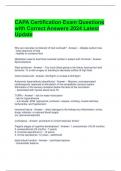Exam (elaborations)
CAPA Certification Exam Questions with Correct Answers 2024 Latest Update
- Course
- Institution
CAPA Certification Exam Questions with Correct Answers 2024 Latest Update Why are neonates not tolerant of fluid overload? - Answer- - obligate sodium loss - slow clearance of fluid - inability to conserve fluid Medication used to treat fluid overload/ ascites in patient with Cirrhosis -...
[Show more]



